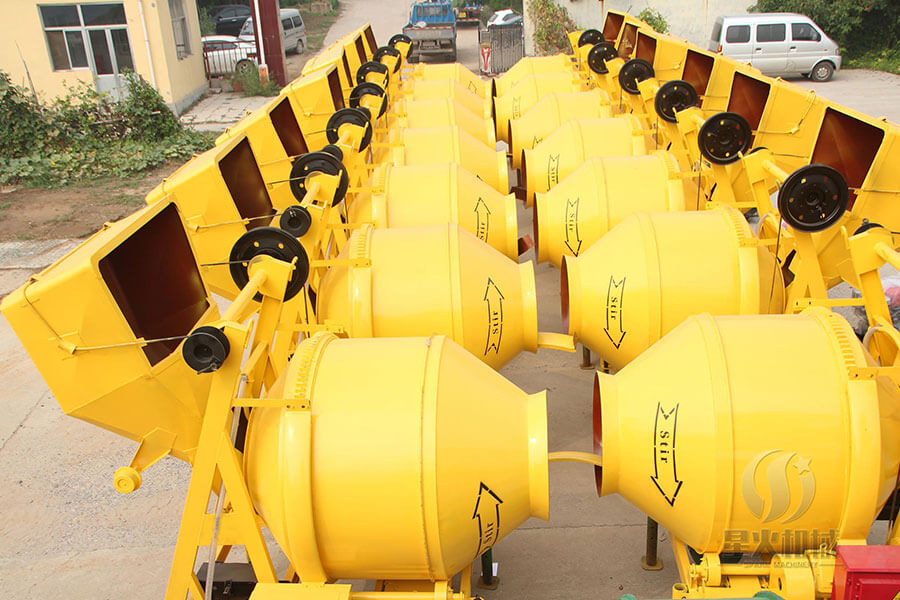Product classification of concrete mixers
Concrete mixers are key equipment used in construction projects to mix raw materials such as cement, aggregates, and water. According to different design principles and application scenarios, concrete mixers can be divided into many types. The following classification is based on four dimensions: working principle, discharging method, moving method, and mixing capacity.
1. Classification by working principle
1. Self-falling mixers
Self-falling mixers use the gravity of materials to achieve mixing through the rotation of the mixing drum. Blades are provided on the inner wall of the mixing drum. During rotation, the materials are lifted to a certain height and then fall freely. The effect of uniform mixing is achieved through mutual collision and friction between materials. This type of mixer has a simple structure and low cost, and is suitable for mixing plastic concrete with ordinary aggregates. However, the mixing efficiency is low, and it is not suitable for mixing high-strength or dry hard concrete.
2. Forced mixers
Forced mixers rely on the high-speed rotation of the mixing blades to force the materials to produce shear, extrusion, and convection in the mixing chamber, thereby mixing quickly. It has high mixing efficiency and good mixing uniformity, and is suitable for mixing dry hard concrete, lightweight aggregate concrete and high-strength concrete. According to the arrangement of the mixing shaft, forced mixers can be divided into horizontal and vertical types:
Horizontal mixer: The mixing shaft is placed horizontally, the blades are spiral, the mixing range is large, and it is suitable for large projects.
Vertical mixer: The mixing shaft is placed vertically, the structure is compact, and it is mostly used in small and medium-sized projects.
2. Classification by discharge method
1. Tilt mixer
The mixing drum of the tilt mixer can rotate around the horizontal axis, and the concrete is poured out by tilting the drum after the mixing is completed. This type of mixer has a fast discharge speed and is suitable for occasions where frequent unloading is required, but the equipment is large and inconvenient to move.
2. Non-tipping mixer
The mixing drum of the non-tipping mixer is fixed, and the concrete is discharged from the bottom or side discharge port by relying on the design of the mixing blades or additional devices. Its structure is relatively simple, it occupies a small area, and is suitable for construction sites with limited space.
3. Classification by movement mode
1. Fixed mixer
Fixed mixer is installed on a fixed foundation and is usually used in large construction sites or concrete mixing plants. It has a large mixing capacity and high stability. It can operate continuously for a long time, but it cannot be moved. It is suitable for large-scale production in fixed places.
2. Mobile mixer
Mobile mixer is equipped with a walking device and can be flexibly moved according to construction needs. There are two common types: tire type and crawler type:
Tire mixer: It moves by tires and has strong mobility. It is suitable for scenes that require frequent transfers such as road construction.
Crawler mixer: It uses a crawler chassis and can adapt to complex terrain, such as mountains or muddy sites.
4. Classification by mixing capacity
1. Small mixer
The mixing capacity of a small mixer is generally less than 0.3 cubic meters. It is small in size and easy to operate. It is suitable for small construction projects or home decoration. Its power is mostly electric motors or gasoline engines, which are flexible to move, but the production efficiency is low.
2. Medium mixers
The mixing capacity of medium mixers is between 0.3 and 1.5 cubic meters, with balanced comprehensive performance, and is widely used in small and medium-sized construction projects. Such equipment usually has good mixing efficiency and stability, and can meet most conventional construction needs.
3. Large mixers
Large mixers have a mixing capacity of more than 1.5 cubic meters and are mainly used in large infrastructure construction or concrete mixing plants. Its complex structure and high power can achieve efficient and continuous operation, which is suitable for the high-intensity needs of large-scale projects.
Conclusion
Concrete mixers can be classified in various ways, and each type has its unique advantages and applicable scenarios. When choosing a mixer, it is necessary to comprehensively consider factors such as project scale, concrete type, and construction environment to ensure that the equipment performance matches the actual needs. With the continuous advancement of technology, concrete mixers are developing in the direction of intelligence, efficiency, and environmental protection, providing strong support for the sustainable development of the construction industry.

